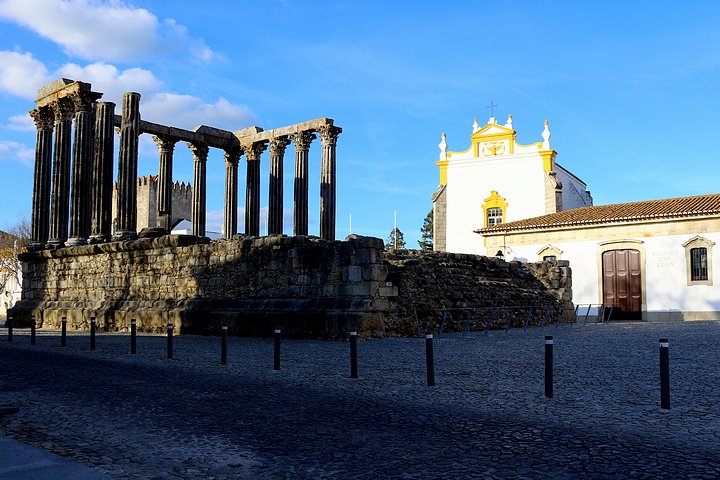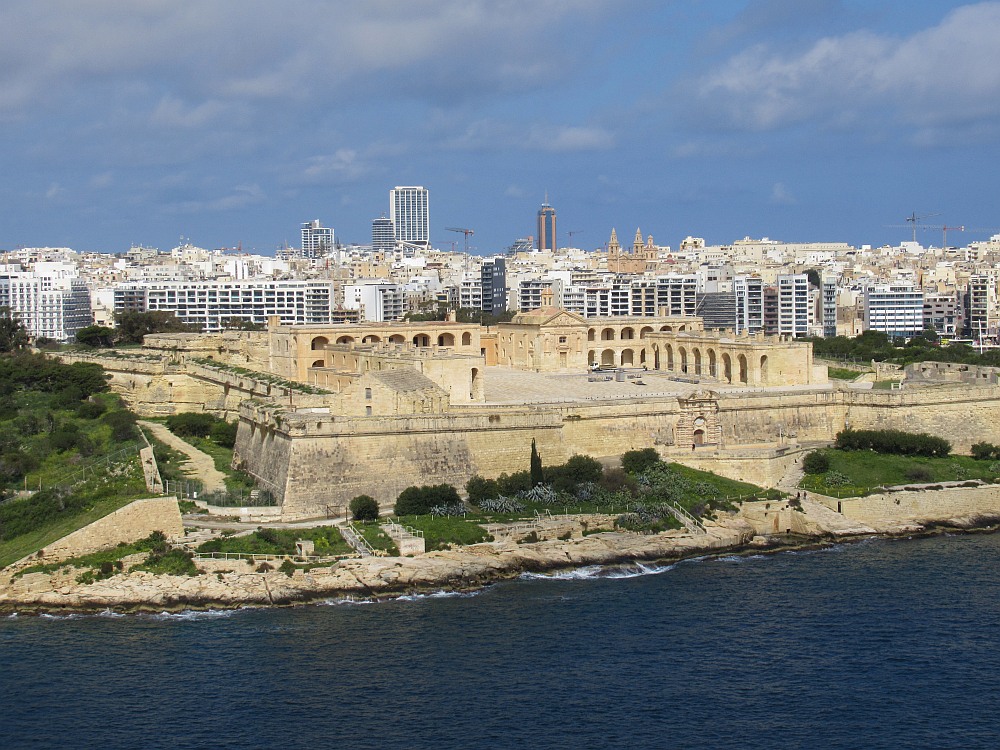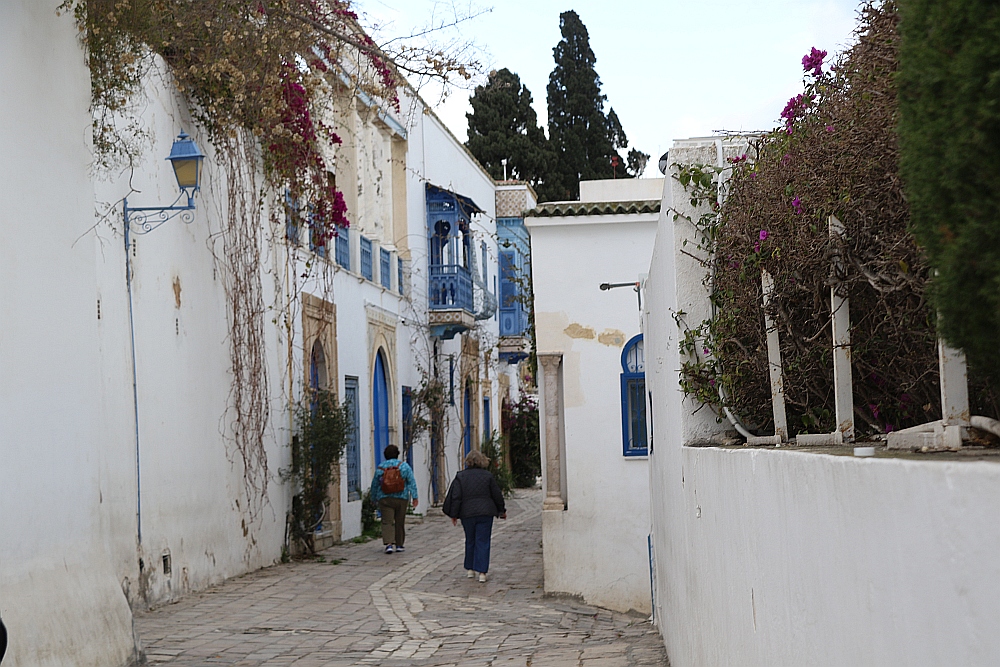Back Roads Of Iberia: Spanish Paradores and Portuguese Pousadas Day 5
Back Roads Of Iberia: Spanish Paradores and Portuguese Pousadas
Day 05 - Tuesday, March 28, 2017 - Travel to Évora; Visit Carpet and Tapestry Making; Wine Production, Cork Factory
We woke up to a gray day; the temperature was 52 degrees with a heavy fog and 94% humidity. Our departure schedule was for 9:00 am. Everyone was on time, the luggage was packed in the bay under the bus, and we were able to leave a few minutes early.
We left the city by way of the 25th of April Bridge. Heading south and east, we traveled through bedroom communities and industrial centers. Rikardo talked about the benefits Portugal and Spain gained as members of the European Union. Before the EU, he said, "We lived in black and white and now we live in color."
The misunderstanding is that there are open borders, but the Schengen Agreement gives freedom to the residents of the EU to travel freely. There is tight immigration control for Non-EU members.
As the fog burned off and the sun came out, we could see olive groves, cork trees, and vineyards in the province of Alentejo. The excellent new highways were built by the European Union funds to bring fresh fruits and vegetables and other agricultural products from the garden of the EU to the other northern countries.
Our morning stop was at Arraiolos, a small village famous for their rugs and tapestries. We had a tour of the interpretive center, a restored hospital that told the story of the carpets and wall hangings.
The Moors brought the traditional Islamic rug making to the Iberian Peninsula. Excavations under the streets discovered ancient vats for dying the yarn. An expert named Rui Lobo gave us a detailed explanation of the history of rug making and showed us their extensive collection.
This activity was especially meaningful to us as Vic's mother, Yvonne and his aunts from Brazil were all experts in making these works of art. Even though we appreciate the heirlooms we have in our home, we now know more of the historical significance of the process.
Rikardo gave us 20 minutes to explore on our own. We talked to a few gentlemen at the village square that recommended a specialty of the town, an Empada de Galinha. We sat out on the patio and shared the little empanada like chicken pie at the Café O Gingão.
At the 18th century Monte da Ravasqueira Winery our guide Marina told us about the history of the estate. As we walked about the plantation, our first stop was the Carriage House. Although there are no longer horses on the farm, the family kept the collection of over 30 restored vehicles.
Marina took us on a walk to the wine production center and we went through the phases of wine making. Because the first green shoots of the vines were just sprouting, the winery was not in production, but everyone mentioned the aroma of the past fall's fruit of the vine.
From the winery, we went to the cellar to see the 50 gallon barrels of wine that were resting. Wines already bottled and packed for shipping were ready to be enjoyed all over the world.
The best part of the visit was the tasting when we were able to sample three wines, a white, rosé, and red. There was also Iberian ham, local cheeses, and a white wine jelly and a red wine jam that were delicious.
Marina warned us all that we would have a huge lunch so we tried to refrain from over doing the hors d'oeuvre - she was correct!
The menu was green vegetable soup, a casserole of rice, chorizo, and roast duck, and a fresh lettuce salad. As if that were not enough, we had a flakey pastry with cream and raspberry jelly and fresh pineapple for dessert.
At 3:00 we were back on the road passing through tiny villages with such narrow streets, that we worried that Luis would not be able to maneuver the bus. On our way out of Arraiolos we stopped to get a closer look at the cork trees. The bark, or the actual cork, is harvested every 9 years.
In Azaruja we stopped at the Cortiçarte Cork Factory, where David told us all about the age-old tradition of harvesting cork. A new learning and discovery; the stop was well worth the brief time spent.
David showed us the tools used to strip the cork from the trees. The cork bark was brought to the factory where it was rehydrated and then flattened. Most of their cork was used for wine stoppers but in their gift shop we saw many other products including trivets, coasters, and even shoes, hats, and clothing.
At 5:30 we arrived in Évora at our first real Portuguese pousada. Our lodgings are in an old convent, Convento dos Lóios. Our cell overlooked the cloister – a beautiful setting near the church. We could hear the bells ringing on the hour.
We met Rikardo and the group for a short tour of the city and then found out that one of our favorite tour directors from our last trip to Spain was in town. Rikardo helped us meet with Laura Fernandez - what a wonderful surprise and serendipitous moment!
Our dinner was at 7:30 and then we came back to the room to catch up on our homework and check our messages. It was a late evening but a wonderful day in the countryside of Portugal.
We knew a little about wine, but today we learned even more about the importance of cork. A few little known facts are:
Portugal is the largest cork producer in the world. They produce 70% of the world's cork exports. Portuguese wine is the result of contributions by ancient civilizations such as the Phoenicians, Carthaginians, Greeks, and primarily the Romans. Portugal started to export its wines to Rome during the Roman Empire. Cork and wine – a winning combination!
https://wanderwisdom.com/travel-destinations/Interesting-Facts-About-Portugal
Accommodations: Hotel Convento dos Lóios, Meal: B, L, & D
To receive $100 per person off your first reservation with OAT, mention the following information when reserving your Overseas Adventure Travel Trip:
Mr. Victor Garcia Customer #673062
Overseas Adventure Travel:
Back Roads Of Iberia: Spanish Paradores and Portuguese Pousadas
Rikardo López Elduayen
Comments
We too spent time in that area of Portugal and then Spain some years ago and loved it. Remember the cork trees well.
Have read your travel adventures over the years and decided to send you a note at last. Have enjoyed following your trips. We also were in Spain and Portugal last year, but a very different trip. Mostly a Duro River cruise. The pictures are great to see. Loved your big furry dog friend. Thanks for sharing all these adventures.
What a trip, so educational! Has Vic been speaking Spanish when the opportunity arises?
Post a Comment!Great trip! Are you now going to start Arraiolos?! Great pics! Enjoy
Featured Journal
Day 18: Mediterranean Navigation
Day 18 - Wednesday, March 19, 2025 – Disembark Ship & Return to USA
It was a dark and rainy morning when we put our luggage outside of our cabin door at 4:15. We met three of our fellow passengers also on the same flight...










